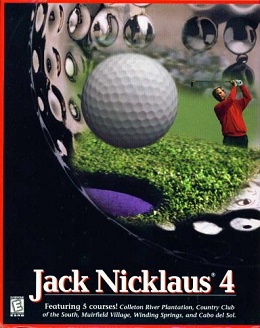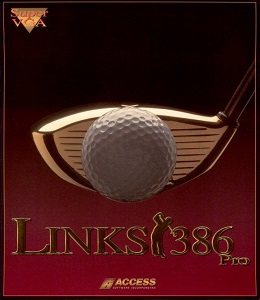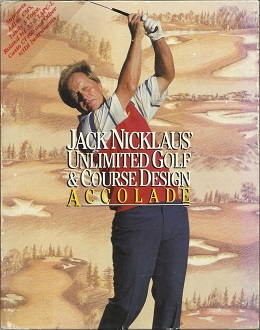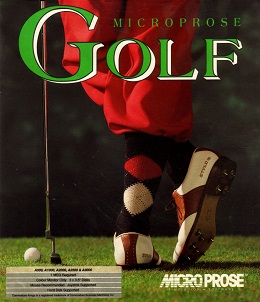
Access Software, Inc. was an American video game developer based in Salt Lake City, Utah. Founded in November 1982 by Bruce Carver and Chris Jones, the company created the Beach Head, Links and Tex Murphy series, as well as Raid over Moscow. Access Software was acquired by Microsoft in April 1999, transitioning in name twice before being acquired by Take-Two Interactive in October 2004, receiving the name Indie Built. In January 2005, Access Software became part of Take-Two's 2K label. Following a poor financial performance at Take-Two, Indie Built was closed down in May 2006.

PGA Tour Golf is a golf video game and the first in the PGA Tour game series. It was developed by Sterling Silver Software and released in 1990, for MS-DOS. It was initially published by Electronic Arts, which subsequently released versions of the game for Sega Genesis and Amiga in 1991, followed by a version for the SNES in 1992. By 1994, Tengen had published versions for Sega's Master System and Game Gear consoles. PGA Tour Golf received generally positive reviews for its realism, sound, and camera. Several critics considered the computer versions to be the best golf game available at the time of its release. It was followed by PGA Tour Golf II.

Jack Nicklaus 4 is a 1997 sports golf video game. It was published by Accolade, and is the fourth in a series of video games named after golfer Jack Nicklaus, following Jack Nicklaus Golf & Course Design: Signature Edition (1992). The original Microsoft Windows version was developed by Cinematronics. Versions were also released for Macintosh and DVD. A PlayStation version titled Jack Nicklaus '98 was also in development. The game was followed by Jack Nicklaus 5, released later in 1997.
Links is a series of golf simulation video games, first developed by Access Software, and then later by Microsoft after it acquired Access Software in 1999. Microsoft also produced its own series of golf games based on Links, under the title Microsoft Golf. The Links series was a flagship brand for Access, and was continued from 1990 to 2003. The first game in the series, Links: The Challenge of Golf, won Computer Gaming World's 1991 Action Game of the Year award.

Links 2001 is a golf video game developed and published by Microsoft. It is part of the Links series and follows Links LS 2000. It is the first game in the series to include a golf course designer, allowing the player to create custom courses. It also features Arnold Palmer, Sergio García, and Annika Sörenstam as playable golfers.

Falcon is a combat flight simulator video game and the first official entry in the Falcon series of the F-16 jet fighter's simulators by Spectrum HoloByte. Originally developed by Sphere for Macintosh and MS-DOS in 1987 and ported to several platforms between 1988 and 1992, the game earned commercial success and critical acclaim.

Jack Nicklaus' Greatest 18 Holes of Major Championship Golf is a golf-simulation video game developed by Sculptured Software, and published by Accolade beginning in 1988. It was released for the Amiga, Amstrad CPC, Apple IIGS, Atari ST, Commodore 64 (C64), MS-DOS, Macintosh, MSX, Nintendo Entertainment System (NES), PC-88, Sharp X68000, and Game Boy.

PGA Tour Golf II is a sports video game developed by American studio Polygames and published by EA Sports for Sega Genesis in 1992 and Time Warner Interactive for Game Gear in 1995.

Links 386 Pro is a golf simulation sports game for MS-DOS released in 1992. It is part of the Links series, and was developed by Access Software as the follow-up to Links: The Challenge of Golf (1990). A Macintosh version, Links Pro, was released in 1994. An enhanced version called Links 386 CD was released for PC in 1995 that included audio comments by comedian Bobcat Goldthwait acting as the player's caddie, and an aerial flyby of each hole streamed from the game's CD-ROM. Re-branded versions of the game were also released for Microsoft Windows under the titles Microsoft Golf 2.0 (1994) and Microsoft Golf 3.0 (1996), part of the Microsoft Golf series.

Links LS 1998 is a golf video game developed and published by Access Software. It is part of the Links video game series, following Links LS (1996). It was released in 1997, and is the first game in the series to be published for Microsoft Windows. The game was well received, and was followed by Links LS 1999.

Jack Nicklaus' Unlimited Golf & Course Design is a 1990 golf video game developed by Sculptured Software and published by Accolade for the Amiga and MS-DOS. A Super NES version with the same golf courses, titled Jack Nicklaus Golf, was released in May 1992. It is the second in a series of golf games named after golfer Jack Nicklaus, following Jack Nicklaus' Greatest 18 Holes of Major Championship Golf (1988).

Jack Nicklaus Golf & Course Design: Signature Edition is a 1992 golf video game developed by Sculptured Software and published by Accolade for MS-DOS. It is part of a series of games named after golfer Jack Nicklaus, and follows Jack Nicklaus' Unlimited Golf & Course Design (1990). Like its predecessor, the game includes a golf course designer that allows the player to create customized courses. Two add-on disks provide additional courses. In 1995, both disks were re-released along with Signature Edition as a compilation titled Jack Nicklaus: The Tour Collection.
Jack Nicklaus is a series of golf video games named after golfer Jack Nicklaus. The first game, Jack Nicklaus' Greatest 18 Holes of Major Championship Golf, was developed by Sculptured Software and published by Accolade. It was released for various platforms beginning in 1988. Accolade would publish subsequent games in the series for the next decade, before selling the rights to Activision in 1998. Activision published a sixth game in the series, Jack Nicklaus 6: Golden Bear Challenge, in 1999, but chose not to publish a sequel due to poor sales. The next game in the series, Jack Nicklaus Perfect Golf, was released by a new company in 2016.

Trump Castle is a series of gambling video games published by Capstone Software between 1989 and 1993. The games are named after Trump's Castle hotel-casino in Atlantic City, New Jersey, and were released for Amiga, Atari ST, Commodore 64, Commodore 128, and MS-DOS.

Links LS 2000 is a golf video game developed by Access Software and published by Microsoft. It is part of the Links series and was released in 1999 for Microsoft Windows, and in 2000 for Macintosh. It was followed by Links 2001.

Microsoft Golf 1998 Edition is a 1998 golf video game developed by American studio Friendly Software and published by Microsoft for Microsoft Windows. It is the fourth game in the Microsoft Golf series, following Microsoft Golf 3.0. The game uses a revamped design that is substantially different from its predecessors.

Links Extreme is a 1999 golf video game developed by Access Software and published by Microsoft for Microsoft Windows. It is the first game in the Links series to be published by Microsoft, which purchased Access Software a month prior to the game's release.

MicroProse Golf is a golf video game developed by The Thought Train and published by MicroProse. It was released in 1991 for Amiga and Atari ST. In 1992, an enhanced MS-DOS version, featuring golf instructor David Leadbetter, was released in the United States as David Leadbetter's Greens and in the United Kingdom as David Leadbetter's Golf. The game's variety was praised, and some critics considered it the best golf game available.

















